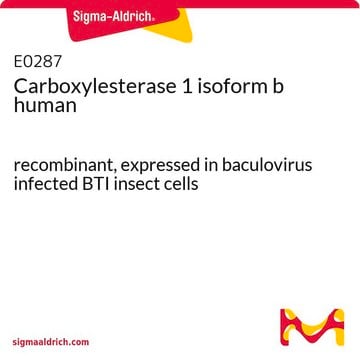C1682
Acetylcholinesterase human
recombinant, expressed in HEK 293 cells, lyophilized powder, ≥1,000 units/mg protein (Lowry)
Synonym(s):
AChE, Acetylcholine acetylhydrolase
Sign Into View Organizational & Contract Pricing
All Photos(5)
About This Item
Recommended Products
General description
Acetylcholinesterase (AChE) is a serine hydrolase, which belongs to the carboxyl esterase family of enzymes. AChE is localised at neuromuscular junctions and cholinergic brain synapses.
Application
Acetylcholinesterase human has been used:
- as a standard protein to measure protein levels acetylcholinesterase AChE-R and AChE-S
- to stimulate human fibroblasts
- to study its in vitro catalytic activity and to determine the effects of metals, H2O2 and OH radicals on the activity
Biochem/physiol Actions
Acetylcholinesterase (AChE) is regarded as a biomarker in neurotoxicity. It is a modulator of nitric oxide signal transduction pathway and marker of membrane integrity and aging. AChE, hydrolyzes choline esters. It terminates the impulse transmission at cholinergic synapses. AChE does this by rapid hydrolysis of the neurotransmitter acetylcholine (ACh) to acetate and choline. AChE inhibitors prevent the cholinesterase enzyme from breaking down ACh and increases the level and duration of the neurotransmitter action.
Major degradative enzyme for acetylcholine in vivo. Converts acetylcholine + H2O to choline + acetic acid.
Unit Definition
One unit will hydrolyze 1.0 μmole of acetylthiocholine to thiocholine and acetate per minute at pH 8.0 at 37 °C.
Physical form
This product is supplied as a lyophilized powder. Lyophilized from 0.22 μm filtered solution in 50mM phosphate buffer pH8.
Analysis Note
The activity obtained using acetylcholine as substrate is 30-100 times that obtained with butyrylcholine, using acetylcholinesterase from electric eel.
Storage Class Code
11 - Combustible Solids
WGK
WGK 3
Flash Point(F)
Not applicable
Flash Point(C)
Not applicable
Certificates of Analysis (COA)
Search for Certificates of Analysis (COA) by entering the products Lot/Batch Number. Lot and Batch Numbers can be found on a product’s label following the words ‘Lot’ or ‘Batch’.
Already Own This Product?
Find documentation for the products that you have recently purchased in the Document Library.
Customers Also Viewed
Sebastian Oddsson et al.
Molecules (Basel, Switzerland), 25(12) (2020-06-26)
Despite extensive efforts in the development of drugs for complex neurodegenerative diseases, treatment often remains challenging or ineffective, and hence new treatment strategies are necessary. One approach is the design of multi-target drugs, which can potentially address the complex nature
Jiayi Liu et al.
Frontiers in plant science, 12, 720816-720816 (2021-08-31)
Essential oils (EOs) are often the source of insecticidal substances of high efficiency and low toxicity. From gas chromatograph-mass spectrometer, column chromatography, and nuclear magnetic resonance spectra analyses, twenty terpenes were identified from the EOs of Artemisia nakaii. These comprised
Acetylcholinesterase from human erythrocytes as a surrogate biomarker of lead induced neurotoxicity
Gupta VK, et al.
Enzyme Research, 2015 (2015)
In vitro effect of H 2 O 2, some transition metals and hydroxyl radical produced via fenton and fenton-like reactions, on the catalytic activity of AChE and the Hydrolysis of ACh
Mendez-Garrido A, et al
Neurochemical Research, 39(11), 2093-2104 (2014)
Agneta Nordberg et al.
Current Alzheimer research, 6(1), 4-14 (2009-02-10)
The current study aimed to compare the effects of different cholinesterase inhibitors on acetylcholinesterase (AChE) and butyrylcholinesterase (BuChE) activities and protein levels, in the cerebrospinal fluid (CSF) of Alzheimer disease (AD) patients. AD patients aged 50-85 years were randomized to
Our team of scientists has experience in all areas of research including Life Science, Material Science, Chemical Synthesis, Chromatography, Analytical and many others.
Contact Technical Service



